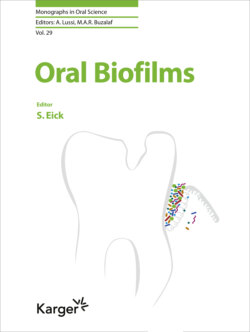Читать книгу Oral Biofilms - Группа авторов - Страница 20
На сайте Литреса книга снята с продажи.
Dental Biofilm Formation
ОглавлениеFirst, before bacteria attach to the tooth surface, a pellicle is formed. The adsorption of proteins to the enamel surface is selective, very fast saliva proteins (acidic proline-rich protein, cystatin, statherin, and protein S100-A9 proteins) attach, while serum proteins attach more slowly [27]. In the subgingival region, more serum-derived proteins are attached to the root surface [28], which can be seen in association with the different surface (cementum) or the flow of the gingival crevicular fluid.
Colonization of microorganisms in the oral cavity and in particular the biofilm formation on teeth depends on many factors, including age, diet, oral hygiene, and the immune response [29]. A few Gram-positive bacteria are able to adhere to pellicle-coated surfaces via specific adhesion-receptor interactions; other microorganisms subsequently attach to them and drive biofilm formation [29]. Analysis of early stages of dental biofilm formation by microarray analysis showed oral streptococci to be most prominent, together with Gemella haemolysans, Haemophilus parainfluenzae, Actinomyces sp., Rothia sp., Neisseria sp., Kingella oralis, Slackia exigua, and Veillonella sp. [30]. Fusobacterium sp. and Parvimonas micra were also present, whereas Porphyromonas gingivalis was not detected [30]. A low presence of Filifactor alocis and of the TM7 complex was linked with a potential role of these bacteria in developing periodontal disease, and the detection of S. mutans in about 25% of individuals can be correlated with potential caries development [30].
Already decades ago, attempts were made to characterize the microbial composition of mature dental biofilms in more detail. In 1993, Kolenbrander and London [31] published a scheme of organization of microorganisms in a subgingival biofilm. The later modified scheme shows that the first oral streptococci, among them S. oralis, S. sanguinis, and S. gordonii, and a few actinomyces (A. oris, A. naeslundii) adhere to the salivary pellicle-coated tooth surface. Then, several other Gram-positive rods and certain Gram-negative bacteria, such as F. nucleatum and Veillonella spp., can attach and provide receptors for late colonizers, including Aggregatibacter actinomycetemcomitans, Treponema denticola, and Tannerella forsythia [32]. A hallmark to describe networking in subgingival biofilm was the creation of different colored complexes by Socransky et al. [33]. By using a checkerboard technique allowing the determination of 40 different bacterial species, bacteria were grouped according to their joined presence, the red complex (P. gingivalis, T. forsythia, and T. denticola) characterized bacteria strongly associated with periodontal disease, the orange complex (F. nucleatum, P. micra,and others) represent the core bacteria, certain oral streptococci were grouped in the yellow complex, V. parvula and A. odontolyticus formed the purple complex, and the green complex consisted of unrelated species [33]. The latest sequencing technologies allow deeper insights into the microbial composition of oral biofilms, revealing that a mature supragingival biofilm is dominated by Streptococcus sp. and Neisseria sp. Furthermore, Gracilibacteria, TM7, Bacteroides, Catonella, Porphyromonas, Tannerella, and others were identified, but not Archaea, yeasts, protozoa, or viruses [34].
The matrix of an oral biofilm contributes to the structural integrity and protects the biofilm against environmental insults [35]. Molecules penetrate through channels and pores, and microorganisms metabolize nutrients, resulting in very different conditions (e.g., pH, redox potential) in short distances, which allows the co-existence of different microorganisms [35]. However, the composition of the oral biofilm matrix has not been well studied. Glycoconjugates binding to 10 lectins were identified in pooled supragingival biofilm samples [36]. Recently, extracellular DNA was visualized in vivo in dental biofilms as an important component for biofilm stability [37]. Among the extracellular polysaccharides, synthesis and the role of glucans are best described, but how other bacterial-produced polysaccharides (polymers being rich in mannose and capsular polysaccharides) contribute to the extracellular matrix remains to be determined [38].
A synergistic interaction with other bacteria is also essential in the oral biofilms. Several periodontal pathogens can grow and multiply only in the presence of other bacteria [39]. Communication is of importance in biofilm formation and maintenance. Oral bacteria produce two major classes of signaling molecules, the competence-stimulating peptides (CSP) and autoinducer-2 [39]. CSP are synthesized by Gram-positive bacteria, they promote biofilm formation, DNA release, and may inhibit bacteriocins produced by S. mutans [39]. Autoinducer-2 production seems to be of importance in the communication of periodontopathogens [39].
